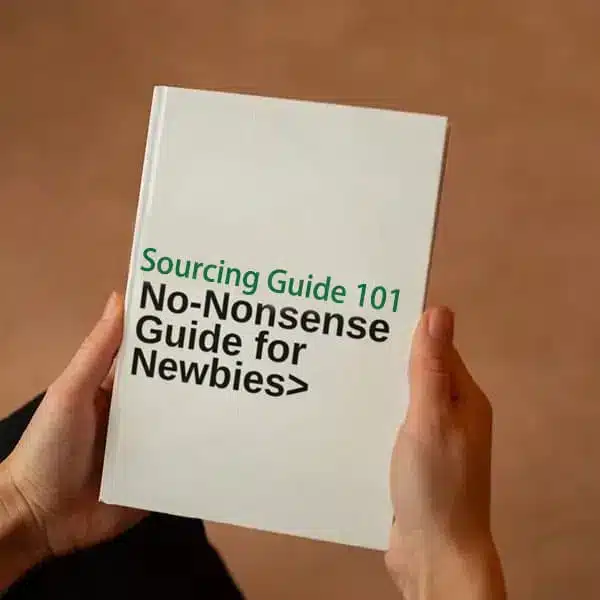Introduction – The Final Hurdle: Shipping
You’ve done it. Your products are ordered (maybe even produced.), and you’re ready for the exciting final step: getting them from the factory in China all the way to your doorstep or warehouse. Shipping might seem complicated, with lots of jargon and choices, but it’s a super important part of the puzzle. Picking the right shipping method can make a huge difference to your final costs and how quickly you receive your goods.
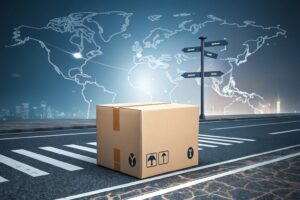
Whether you’re shipping a small box of urgent samples or a massive container full of stock, there’s a solution out there for you. The trick is knowing which method fits your specific needs – balancing speed, cost, and the size of your shipment.
Let’s break down the main ways to ship from China and help you figure out the best route for your business.
The Players – Who Actually Handles Your Shipment?
Shipping isn’t usually just one company doing everything. There are a few key players involved in moving your goods internationally.

-
The Seller/Shipper: This is your supplier in China who gets the goods ready.
-
You (The Buyer/Consignee): That’s you. The one receiving the goods.
-
Shipping Companies (Carriers): These are the companies that physically own and operate the ships, planes, trucks, or trains (e.g., Maersk Line, China Southern Airlines, UPS’s airline). They handle the actual transport. There are usually different companies involved for trucking in China, the main international leg, and trucking in your country.
-
The Freight Forwarder1: Your Shipping Coordinator. This is often the most crucial player for importers. Think of them as your shipping agent2 or travel agent for cargo.
-
What they do: Freight forwarders don’t typically own the ships or planes. Instead, they act as intermediaries. They book space with the carriers, arrange trucking, handle export/import documentation and customs procedures, consolidate smaller shipments (LCL), and basically coordinate the whole process from (near) the factory door to (near) your door.
-
Why you need one (usually): Unless you’re using simple courier services or DDP terms (where the supplier handles it all), you’ll likely need a freight forwarder, especially for sea or air freight. They have the expertise and connections to manage the complex logistics.
-
Finding a Good One: There are thousands of forwarders. Some are large global companies, others small local operations. Getting recommendations, checking reviews, or using platforms like Freightos (which allows you to compare quotes online, though often just port-to-port) can help. Be wary of quotes that seem too good to be true – ensure they cover all expected fees. A good forwarder is worth their weight in gold. Your supplier might recommend one, or a sourcing agent like Green Sourcing can help arrange reliable shipping.
-
Quick Refresher – How Incoterms Tell You Who Arranges Shipping
Remember those trade terms from Chapter 7 (FOB, EXW, CIF, DDP)? They directly impact who is responsible for arranging and paying for the main international shipping.
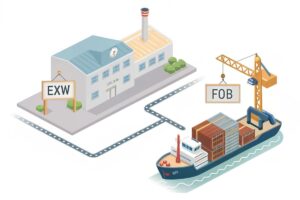
-
EXW (Ex Works)3: YOU (or your forwarder) arrange everything from the factory door onwards.
-
FOB (Free On Board): Your supplier gets it to the Chinese port and handles export customs. YOU (or your forwarder) arrange the main sea/air freight, insurance, and import process. (Most common term when using your own forwarder).
-
CIF (Cost, Insurance, Freight)4: Supplier arranges main freight and basic insurance to your destination port. YOU handle import customs, duties, and delivery from the port (watch out for high destination fees).
-
DDP (Delivered Duty Paid): Supplier arranges and pays for EVERYTHING, right to your door. Easiest for you, but usually the most expensive overall cost per item.
Key Takeaway: Knowing your Incoterm tells you at what point the shipping responsibility (and cost) shifts from the supplier to you.
Option 1 – Express Courier (DHL, FedEx, UPS, TNT)5: Need it YESTERDAY?
If you need small quantities, samples, or urgent items delivered quickly, international couriers are often the best bet.
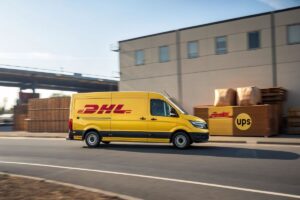
-
Best For: Shipments generally under 500kg (though weight isn’t the only factor), samples, important documents, high-value items where speed justifies cost.
-
Pros:
-
Fast: Usually the quickest option, typically 3-7 working days door-to-door worldwide.
-
Easy: Relatively simple process. Couriers handle pickup, transport, and customs clearance (though you still pay duties/taxes).
-
Simple Quotes: Pricing is usually straightforward per kilogram (kg), door-to-door.
-
Good Tracking: Easy to track your package online.
-
-
Cons:
-
Expensive: By far the highest cost per kilogram compared to other methods.
-
Dimensional Weight Trap: This is crucial. Couriers charge based on whichever is higher: the actual weight OR the dimensional (volumetric) weight. They calculate dimensional weight using a formula like (Length cm x Width cm x Height cm) / 5000. A large but light box (like foam packaging or pillows) can end up costing a lot based on its size, not its actual weight.
- Example: A box is 50x50x50 cm and weighs 10kg. Its dimensional weight is (50*50*50)/5000 = 25kg. You’ll be charged for 25kg, not 10kg.
-
Restrictions: Strict rules about shipping items like batteries, liquids, powders, and magnets. Often require special handling and paperwork, or may be prohibited altogether.
-
Small Parcel Penalty: Shipping a tiny parcel (like under 1kg) can have a disproportionately high cost per kg, sometimes $20+ just for a document or a tiny sample bottle.
-
-
Pro Tip: Don’t book directly with DHL/FedEx yourself. Suppliers and forwarders get significant volume discounts (often 40%+) through their agents. Let them arrange courier shipping for you.
Use Case: Sending final product samples for approval, fulfilling an urgent small order for a key customer, shipping lightweight but high-value electronics.
Option 2 – Sea Freight: The Slow & Steady Budget Champion
For larger quantities where cost saving is more important than speed, sea freight is the king. It’s the backbone of global trade.
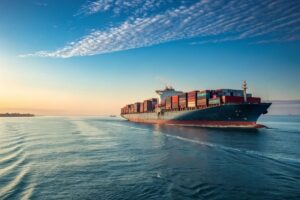
-
Best For: Shipments typically larger than 2 Cubic Meters (CBM), non-urgent bulk orders, heavy or large items.
-
Pros:
- Cheapest: Lowest cost per kilogram or CBM for large volumes. Significantly cheaper than air or courier.
-
Cons:
-
SLOW: Takes a long time. Transit on the water alone can be 3-6 weeks, plus time for trucking, port handling, and customs. (e.g., China to US West Coast: ~25-35 days port-to-port; to Europe: ~40-50 days).
-
Needs a Freight Forwarder: You absolutely need a forwarder to manage the booking, documentation, customs, and coordination.
-
Complex Pricing: Quotes involve many line items (local trucking, port fees, export fees, ocean freight, destination port fees, customs fees, delivery – see example cost breakdown in original docs).
-
Volatility: Costs fluctuate wildly based on global demand, fuel prices, port congestion, and season (e.g., prices skyrocket before Chinese New Year and peak shopping seasons). Recent years have seen extreme price swings. Get current quotes.
-
Damage Risk: Longer transit and more handling points mean a slightly higher risk of damage if goods aren’t packed properly.
-
-
FCL vs. LCL:
-
FCL (Full Container Load): You rent a whole container (usually 20ft or 40ft). Best value if your shipment is large enough to mostly fill it (roughly >15-20 CBM). Safer as your goods aren’t mixed with others.
-
LCL (Less than Container Load): Your goods share space in a container with other importers’ cargo. Good for shipments between ~2 CBM and ~15 CBM. Priced per CBM or per Ton (whichever is greater). Can be slightly slower than FCL due to consolidation/deconsolidation steps.
-
Use Case: Importing furniture, large quantities of apparel, building materials, heavy machinery parts, any bulk stock where transit time is flexible.
Option 3 – Air Freight: Faster than Sea, Cheaper than Courier Sometimes
Air freight occupies a middle ground. It’s faster than sea but generally slower and more complex than express courier. It can be more cost-effective than courier6 for heavier shipments.
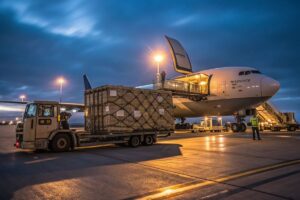
-
Best For: Shipments often over 500kg where speed is important but courier costs are prohibitive. High-value goods where holding cost is a factor.
-
Pros:
-
Faster than Sea7: Significantly faster transit times (usually 5-10 days airport-to-airport).
-
Potentially Cheaper than Courier (for heavy): For shipments above a certain weight (e.g., >300-500kg), the per-kilo rate might become lower than express courier rates.
-
Better Dim Weight Factor (Sometimes): Air freight often uses a dimensional weight divisor of 6000 (vs. 5000 for courier), meaning dimensional weight charges might be slightly lower for the same size box compared to courier.
-
-
Cons:
-
Still Expensive: Much pricier than sea freight.
-
Needs Forwarder/Broker8: Operates airport-to-airport. You need a freight forwarder to handle booking, ground transport, and a customs broker for import/export clearance (more complex than courier’s integrated process).
-
Less Simple: More steps and paperwork involved compared to all-in-one courier services.
-
Use Case: Replenishing stock of valuable electronics quickly, shipping seasonal fashion items that need to arrive faster than sea allows, urgent parts needed for manufacturing.
Option 4 – Railway Freight: The China-Europe Land Bridge
A growing option specifically for shipping between China and Europe, offering a unique balance.

-
Best For: Shipments going to/from China and many parts of Europe (especially inland areas far from seaports).
-
Pros:
-
Faster than Sea: Significantly quicker transit, typically 15-20 days terminal-to-terminal.
-
Cheaper than Air: Much less expensive than air freight (maybe around 2x sea freight cost).
-
Good Balance: Hits a sweet spot between speed and cost for many European importers. Can improve cash flow compared to slow sea freight.
-
-
Cons:
-
Limited Routes9: Network primarily serves specific routes between China and Europe.
-
Mainly FCL: Most freight forwarders offer railway primarily for Full Container Loads (FCL), making it less accessible for small importers needing LCL-equivalent options.
-
Still Requires Forwarder: Logistics need to be managed by a capable freight forwarder.
-
Use Case: A German company needing regular stock replenishment from China, finding sea too slow and air too costly.
Option 5 – Hybrid Sea + Local Delivery: Smart Shipping for E-commerce
Clever freight forwarders have developed hybrid solutions10, particularly popular for Amazon FBA sellers and other e-commerce businesses.
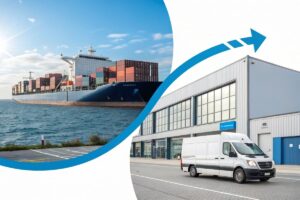
-
How it Works: Combines the low cost of sea freight for the long trans-Pacific/trans-Atlantic journey with faster final-mile delivery11 using local couriers (like UPS, FedEx) or trucking networks once the container arrives in the destination country (e.g., US, UK, Germany).
-
Best For: E-commerce sellers shipping medium-sized quantities (e.g., 50kg – 500kg, or several cartons) directly to fulfillment centers (like Amazon FBA) or their own warehouses, needing something faster than traditional LCL sea freight but cheaper than air freight.
-
Pros:
-
Good Cost/Speed Balance: Often around 2x the cost of traditional sea freight but delivers much faster (e.g., ~20-25 days total China to US warehouse, vs 40-60+ days for LCL). Reduces cost significantly compared to air (maybe 20-50% cheaper).
-
Simplified Delivery: Forwarder handles the complex import and arranges final delivery via familiar local carriers.
-
-
Cons:
-
Requires Capable Forwarder: Need a forwarder specializing in these e-commerce/FBA solutions.
-
Slightly Slower than Air: Still takes longer than pure air freight or express courier.
-
Use Case: An Amazon seller sending 15 cartons of new inventory from China directly to a US FBA warehouse.
Option 6 – ePacket / Postal Services: For Tiny, Low-Value Parcels Only
This is the ultra-low-cost option12 often used by sellers on platforms like AliExpress for dropshipping small, cheap items directly to consumers.

-
Best For: Very small parcels (under 2kg), low-value items (cheap jewelry, phone accessories, small gadgets) where shipping cost is the absolute primary concern.
-
Pros:
-
Extremely Cheap13: Often the cheapest possible shipping method, charged by the gram.
-
Low Starting Weight: Can ship items as light as a few grams economically.
-
-
Cons:
-
VERY Slow: Transit times are long and unpredictable (10-20 days is optimistic, can often take 30+ days or more).
-
Unreliable Tracking14: Tracking is often basic and may not update accurately once it leaves China.
-
Easily Lost: Higher risk of packages getting lost in the postal system with little recourse.
-
Not for Business Inventory: Unsuitable for shipping stock to your own warehouse or FBA due to unreliability and lack of professional handling/customs clearance.
-
Use Case: Primarily for dropshippers sending individual, low-cost items directly from a Chinese supplier to an end customer worldwide.
Conclusion
Choosing the right shipping method is a balancing act. You need to consider:
- How big/heavy is your shipment? (Volume/Weight)
- How fast do you need it? (Urgency)
- What’s your budget? (Cost)
- What kind of product is it? (Value, restrictions)
From lightning-fast (but pricey) couriers to slow (but cheap) sea freight, and clever hybrid options in between, there’s a solution for every need.
Our Advice? Don’t navigate this alone. Working with a reliable freight forwarder is essential for most import methods (especially sea and air). And of course, a good sourcing partner like Green Sourcing can not only help you find suppliers but also manage the entire shipping process, leveraging our network and expertise to find the best, most cost-effective solution for your specific situation. We handle the complexities so you can focus on growing your business.
Congratulations on reaching the end of this crucial chapter – you’re now equipped to make smart shipping decisions.
-
Understanding the role of a Freight Forwarder is crucial for efficient shipping. Explore this link to learn how they can simplify your logistics. ↩
-
Discover the vital functions of a shipping agent in international logistics and how they can streamline your shipping process. ↩
-
Understanding EXW is crucial for managing shipping responsibilities and costs effectively in international trade. ↩
-
Learn about CIF to ensure you know what costs are covered by your supplier and what you need to handle. ↩
-
Explore the advantages of express couriers for urgent shipments and understand their pricing structure. ↩
-
Explore this link to understand how air freight can save costs for heavier shipments compared to courier services. ↩
-
Discover the advantages of air freight over sea freight, especially for urgent shipments that require quick delivery. ↩
-
Learn why using a freight forwarder is crucial for navigating the complexities of air freight logistics and customs. ↩
-
Learn about the challenges and limitations in shipping routes to better plan your logistics strategy. ↩
-
Explore this link to understand how hybrid solutions can optimize shipping for e-commerce businesses, especially Amazon FBA sellers. ↩
-
Learn about final-mile delivery to see how it impacts shipping efficiency and customer satisfaction in e-commerce. ↩
-
Explore this link to understand the benefits and drawbacks of using ultra-low-cost shipping options for dropshipping. ↩
-
Discover why Extremely Cheap shipping is favored by dropshippers and how it impacts their business model. ↩
-
Learn about the challenges of Unreliable Tracking and how it affects customer satisfaction in e-commerce. ↩


